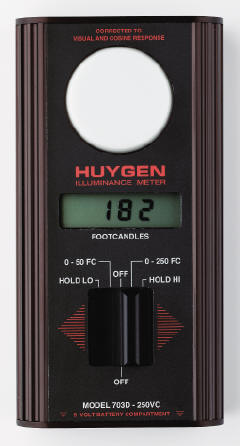
HUYGEN
?n style="font:7.0pt "Times New Roman""> LIGHT METERS and PHOTOVOLTAIC CELLS
In 1984 Huygen Corporation acquired the manufacturing and calibration equipment plus intellectual property rights for Weston Instruments? line of industrial light meters and photovoltaic cells. We manufactured and calibrated the Models 703, 614 and 615 under the Weston name for several years and thereafter under the Huygen Corporation name. We continue to support those Weston models with calibration services to both military and NIST standards and with repair services when required. The three models were also upgraded to permit easier and more accurate calibration. These were predominantly illuminance meters with photopic response, but the 615 series could be hooded and calibrated as a luminance (brightness) meter.
Lightmeters
The Huygen 703D Dual Range Digital Lightmeter was introduced in October, 2001. It is a rugged industrial meter housed in an extruded aluminum case and configured for either illuminance or luminance measurements. For photometric accuracy and long term stability, photopic (human eye) color response is obtained by the combination of Viscor笡ss filters and selenium Photronic?ls. Basic unfiltered Photronic?ls have a peak response near that of the human eye, 550nm, and no response in the infrared portion of the spectrum. They measure only light and ignore heat from hot light sources or high temperature surroundings. This is in contrast to silicon sensors which have an intrinsic peak response in the infrared portion of the spectrum and measure heat as well as light. At the opposite end of the visible spectrum, our selenium detectors can be filtered and calibrated for ultraviolet measurements. This makes the Model 703D quite flexible with configurations available to cover a wide range of visible light and ultraviolet radiation measurements.
All Huygen lightmeters are calibrated at multiple points to NIST standards and a calibration certificate is included with each shipment. Production runs of the 703D to date have been registering accuracies to within 堯n both the high and low ranges, as opposed to the 堦igure printed in the catalog. These calibration levels vary from tenths and hundredths of a footcandle for parking lot and security lighting applications to the 500+ footcandle levels for hospital/medical applications and stage or radiographic projector measurements. Calibration repeatability and accuracy is made possible by our maintenance of three large bar photometers accompanied by NIST calibrated optical filters plus an inventory of lamp transfer standards for illuminance and color temperature that are powered by large, precision dc lamp power supplies

Model 703D-250VC Illuminance Meter A Sturdy and Accurate Meter.....A Tool for Professionals
Several models of the 703D with their ranges and filters are described and listed in the printed brochure. The listing is useful for selecting the most popular and normally stocked meters. Special illuminance calibrations and luminance meters built on the same extruded aluminum frame are also available. The filters and detector for luminance meters are mounted in a "snoot" that is positioned on the back side of the instrument so that readings can be made with the detector facing the light source. As a starting point in selecting a meter, the following paragraph about filters should be helpful.
Specify a Viscor橬ter (V) when illuminance measurements must be reported in footcandles or lux and when luminance (photometric brightness) measurements must be reported in footlamberts or candelas per unit area. Those measurements require photopic response to ensure that both natural and all artificial lighting will be sensed as the human eye would. Specify a cosine filter (C) when side lighting should be included, as when measuring lighting in a hallway with multiple fixtures or task lighting in a room with ceiling lamps or windows. A cosine filter is not used on luminance meters because the instrument?uot;snoot" restricts the viewed area on the surface being measured. Inconel filters (I) provide an extremely stable neutral density coating that is required on high intensity luminance meters, such as those used to measure the surface of radiographic projectors or sunlight measuring instruments. Quartz (Q) and special bandpass filters are used for ultraviolet measurements that can extend down to 260nm for our selenium detectors. Contact one of our engineers by phone, fax or E-mail to discuss your particular application and the best model for your needs. We can also identify and cross reference government and military stock numbers for both Weston and Huygen meters.